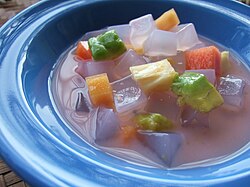 Nata de coco are the translucent cubes in this fruit salad | |
| Type | Confectionery or dessert |
|---|---|
| Place of origin | Philippines |
| Region or state | 3 |
| Main ingredients | Coconut water |
Nata de coco, also marketed as coconut gel, is a chewy, translucent, jelly-like food produced by the fermentation of coconut water,[1] which gels through the production of microbial cellulose by Komagataeibacter xylinus.
Originating in the Ramon, Isabela, nata de coco was invented in 1949 by Teódula Kalaw África as an alternative to the traditional Filipino nata de piña made from pineapples. It is most commonly sweetened as a candy or dessert, and can accompany a variety of foods, including pickles, drinks, ice cream, puddings, and fruit cocktails.[2][3]
- ^ Sanchez, P.C. (2008). Philippine Fermented Foods: Principles and Technology. University of the Philippines Press. p. 378. ISBN 978-971-542-554-4.
- ^ Cite error: The named reference
Vergarawas invoked but never defined (see the help page). - ^ Sharangi, Amit Baran; Datta, Suchand (2015). Value Addition of Horticultural Crops: Recent Trends and Future Directions. Springer. p. 151. ISBN 9788132222620. Archived from the original on July 13, 2023. Retrieved April 21, 2017.